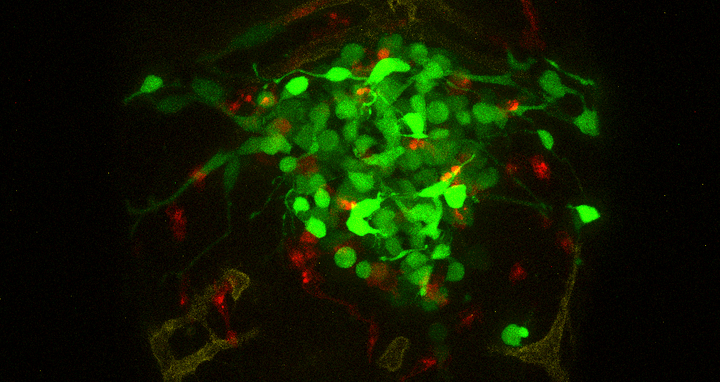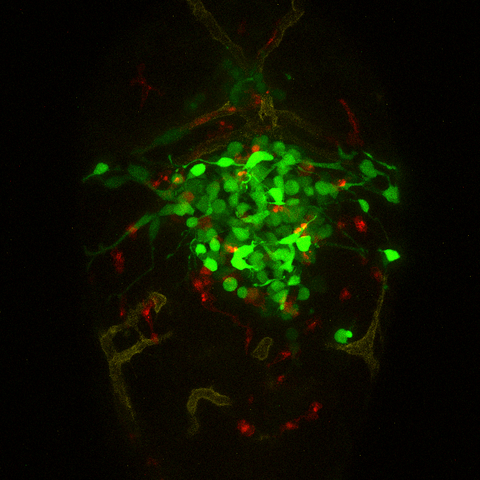Avatars to help tailor glioblastoma therapies
Joint press release – Max Delbrück Center, VIB, and KU Leuven
Glioblastoma is an aggressive and difficult-to-treat brain tumor in adults. On average, patients survive for only 1.5 years. The standard of care treatment for this disease, which includes surgery followed by radiation and chemotherapy, has not changed in 18 years. That’s partly because the cancer is highly variable with many differences across the patient population. Secondly, these cancer cells also deceive the body in insidious ways: they even recruit immune cells called macrophages to help them. And thirdly, they are out of reach for most anti-cancer drugs, which have only a limited capacity to penetrate brain tissues. Besides the standard of care treatment, oncologists try out drugs on glioblastoma patients without any guarantee they’ll work, often involving adverse side effects.
These patients really are in need of new therapies. It is very important to identify the patients who do respond to a specific treatment, and the ones who do not.
“These patients really are in need of new therapies,” says Professor Holger Gerhardt, the senior author of the study and vice-Scientific Director of the Max Delbrück Center in Berlin. “It is very important to identify the patients who do respond to a specific treatment, and the ones who do not.”
Lise Finotto, the lead author and a cancer researcher at the VIB-KU Leuven Center for Cancer Biology in Belgium and formerly at the Max Delbrück Center, and her senior collaborators Gerhardt and Professor Frederik De Smet at KU Leuven, have created a screening platform that could be refined to find novel targets for drugs against glioblastoma. It could also be used to check if a particular patient will respond to a therapy. The study was published in “EMBO Molecular Medicine.”
To understand how macrophages can interact with glioblastoma cells of different patients, the researchers created zebrafish “avatars.” Gerhardt’s lab works extensively with zebrafish. These three-centimeter-long fish are considered good model organisms as their embryos are translucent, making it possible to monitor what’s happening inside.
An unexpected survival
Brain region of a zebrafish avatar bearing a human glioblastoma tumor: patient-derived tumor cells (green) growing in a zebrafish embryo with its vascular network labeled in yellow, and its macrophages, a type of immune cell, in red.
Finotto investigated glioblastoma stem cells from seven patients collected by scientists at the De Smet lab, which is establishing a living tissue bank of glioblastoma samples. She injected them into zebrafish embryos, creating xenograft models – an avatar for each specific patient. When she live-imaged the embryos, it appeared that the glioblastoma cells had adapted well to their new environment. She saw the zebrafish’s immune system sending macrophages as part of an immune response to control the tumor. But as is typical in glioblastoma, the macrophages were suppressed. The tumors have several mechanisms to reprogram the macrophages so they help them grow.
"We wanted to learn how to revert the macrophages to a tumor-attacking state,” Finotto says. And a clue surfaced when they noticed that the tumor of one patient did not suppress the normal macrophage response.
“Upon closer investigation of the medical details, we discovered that this patient was what we call a 'long-term survivor’,” says De Smet at KU Leuven. “It’s a term used for glioblastoma patients with a survival of more than five years, which is exceptionally rare in this brain cancer.”
Testing platform
Their curiosity about the patient became the driving force behind the project, Finotto says. When they cultured the tumor cells and macrophages together and did single-cell RNA sequencing, they learned that one gene, LGALS1, was downregulated in the tumor of the long-term survivor compared to the others. Earlier studies have also shown that silencing of LGALS1 in glioblastoma cells can result in longer survival.
Time-lapse video of a zebrafish avatar: By imaging the brain of a zebrafish embryo over time, scientists can follow the dynamic interaction of patient-derived glioblastoma tumor cells (green) and macrophages (red). The brain’s vascular network is labeled in yellow. In this case, the scientists imaged the avatar for more than 15 hours.
The scientists confirmed their results by knocking out the gene in another patient’s sample and observed in the zebrafish models that the tumor became less invasive.
This platform could be used to identify promising targets other than LGALS1 for the treatment of glioblastoma, Finotto says. And with some refinement, zebrafish avatars could be used to identify which treatments will work. Researchers could investigate whether the tumor cells from particular patients grafted into zebrafish respond when treated with various drugs to find the ones that lead to tumor regression, Gerhardt says.
“Armed with this information, we could inform oncologist and help them to make more supported treatment decisions for the patient,” De Smet says.
gav
Further information
- Laboratory for Precision Cancer Medicine at KU Leuven
- Leuven Living Tissue Lab
- VIB-KU Leuven Center for Cancer Biology
Literature
Lise Finotto et al. (2023): „Single-cell profiling and zebrafish avatars reveal LGALS1 as immunomodulating target in glioblastoma.“ EMBO Molecular Medicine, DOI: 10.15252/emmm.202318144
Image and video to download
Brain region of a zebrafish avatar bearing a human glioblastoma tumor: patient-derived tumor cells (green) growing in a zebrafish embryo with its vascular network labeled in yellow, and its macrophages, a type of immune cell, in red. Image: Lise Finotto, VIB – KU Leuven
Contacts
Prof. Holger Gerhardt
Head of the Integrative Vascular Biology Lab
Vice-Scientific Director
Max Delbrück Center
+49 (0)30 450 540 701
Holger.Gerhardt@mdc-berlin.de
Prof. Frederik De Smet
Head of the Laboratory for Precision Cancer Medicine
Translational Cell & Tissue Research, Dept. of Imaging and Pathology
KU Leuven
+32 (0)16 372 575
frederik.desmet@kuleuven.be
Jana Schlütter
Editor, Communications
Max Delbrück Center
+49 (0) 30 9406 2121
jana.schluetter@mdc-berlin.de or presse@mdc-berlin.de
- Max Delbrück Center
-
-
The Max Delbrück Center for Molecular Medicine in the Helmholtz Association (Max Delbrück Center) is one of the world’s leading biomedical research institutions. Max Delbrück, a Berlin native, was a Nobel laureate and one of the founders of molecular biology. At the locations in Berlin-Buch and Mitte, researchers from some 70 countries study human biology – investigating the foundations of life from its most elementary building blocks to systems-wide mechanisms. By understanding what regulates or disrupts the dynamic equilibrium of a cell, an organ, or the entire body, we can prevent diseases, diagnose them earlier, and stop their progression with tailored therapies. Patients should benefit as soon as possible from basic research discoveries. The Max Delbrück Center therefore supports spin-off creation and participates in collaborative networks. It works in close partnership with Charité – Universitätsmedizin Berlin in the jointly run Experimental and Clinical Research Center (ECRC), the Berlin Institute of Health (BIH) at Charité, and the German Center for Cardiovascular Research (DZHK). Founded in 1992, the Max Delbrück Center today employs 1,800 people and is funded 90 percent by the German federal government and 10 percent by the State of Berlin.
- VIB
-
-
VIB’s core mission is to generate disruptive insights in the molecular underpinning of life and to translate these actively into impactful innovations for patients and society. VIB is an independent research institute where some 1,800 top scientists from Belgium and abroad conduct pioneering basic research. As such, they are pushing the boundaries of what we know about molecular mechanisms and how they rule living organisms such as human beings, animals, plants, and microorganisms. Based on a close partnership with five Flemish universities – Ghent University, KU Leuven, University of Antwerp, Vrije Universiteit Brussel, and Hasselt University – and supported by a solid funding program, VIB unites the expertise of all its collaborators and research groups in a single institute. VIB’s technology transfer activities translate research results into concrete benefits for society such as new diagnostics and therapies and agricultural innovations. These applications are often developed by young start-ups from VIB or through collaborations with other companies. This also leads to additional employment and bridges the gap between scientific research and entrepreneurship. VIB also engages actively in the public debate on biotechnology by developing and disseminating a wide range of science-based information. More info can be found on www.vib.be.
- KU LEUVEN
-
-
KU Leuven is Europe’s most innovative university (Reuters) and ranks 42nd in the Times Higher Education World University rankings. As Belgium's largest university, KU Leuven welcomes 65,000 students from over 140 countries. Its 8,000 researchers are active in a comprehensive range of disciplines. KU Leuven is a founding member of the League of European Research Universities (LERU) and has a strong European and international orientation. University Hospitals Leuven, its network of research hospitals, provides high-quality healthcare and develops new therapeutic and diagnostic insights with an emphasis on translational research.







